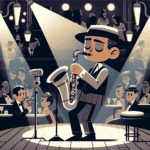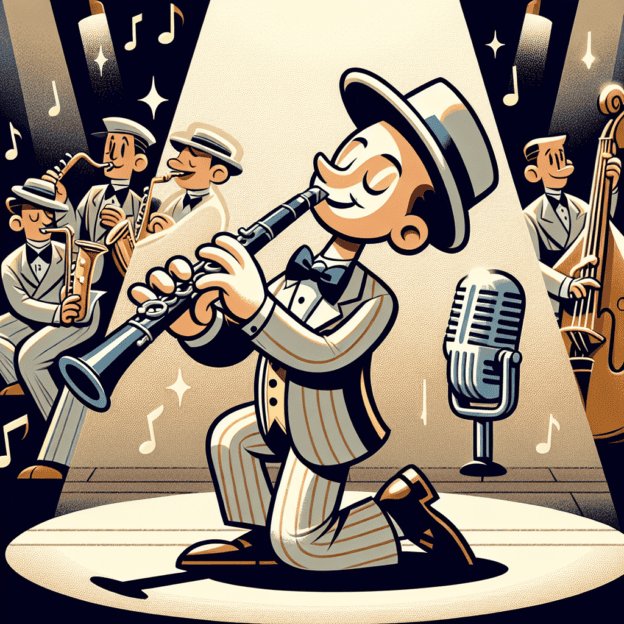Benny Goodman, a name that rings with the vibrant sounds of the swing era, transformed jazz and propelled it into the spotlight of American music during the late 1930s and 1940s. His exceptional clarinet skills and innovative approach made him one of the most influential figures in jazz history. In this article, we'll explore Benny Goodman's life, his impact on the swing era, and offer tips for clarinetists who want to capture his distinctive style.
The Rise of Benny Goodman
Born on May 30, 1909, in Chicago, Illinois, Benny Goodman was the ninth of twelve children in a Jewish immigrant family. His father's strong work ethic rubbed off on the children. Young Benny picked up the clarinet early, displaying a natural talent that led him to study at the Chicago College of Music. By his teenage years, he was already a professional performer.
Goodman's career took off in the 1920s when he joined the band of jazz legend Wedderburn. He then played with various groups, gaining recognition among jazz insiders. But it was in the mid-1930s that Goodman truly shot to stardom, forming his own band and introducing the catchy rhythms of swing music to audiences nationwide.
Benny Goodman: Key Milestones
| Year | Event |
|---|---|
| 1909 | Born in Chicago, Illinois |
| 1920s | Joins Wedderburn's band |
| Mid-1930s | Forms his own band, rise to fame begins |
| 1938 | Landmark performance at Carnegie Hall |
Defining the Swing Era
The swing era brought lively, up-tempo music that highlighted rhythm and improvisation. Benny Goodman earned the title “King of Swing,” leading large dance bands and wowing audiences with his captivating performances and unmatched clarinet playing. His 1938 Carnegie Hall performance was a turning point in jazz history, showcasing the genre's appeal to mainstream America.
The Signature Style of Benny Goodman
Goodman's playing style had several distinct features. Aspiring clarinetists can learn from his techniques:
- Technical Prowess: Goodman's mastery of the clarinet allowed him to play fast, handle tricky passages, and perform complex melodic lines with ease. New players should focus on building technical skills through consistent practice and exercises that improve finger dexterity.
- Rich Tone: His clarinet sound was known for its warmth and clarity. To achieve a rich tone, pay attention to proper embouchure, breath control, and choose the right equipment. Consider investing in quality reeds and mouthpieces, like those from Martin Freres.
- Improvisational Flair: Goodman often improvised during performances, showcasing his creativity and musical expression. For clarinetists, developing improvisation skills is key. Practice improvising over chord progressions and use scales to expand your melodic repertoire.
- Rhythmic Mastery: Goodman knew how important rhythm was in creating energy. Work on rhythmic variety in your playing, incorporating syncopation and swing feel to capture the driving rhythms of the swing era.
Goodman's Clarinet Essentials
- ? Technical mastery
- ? Rich, warm tone
- ? Improvisational skills
- ? Strong sense of rhythm
Collaborations and Influences
Throughout his career, Benny Goodman worked with many notable musicians, including Count Basie and Charlie Christian. These partnerships helped blend different jazz styles and showed off the clarinet's versatility. Goodman was known for incorporating these varied influences into his own playing and arrangements, creating a sound that struck a chord with fans.
Goodman's band launched the careers of many young musicians who would later make their mark in jazz, showing his dedication to fostering new talent and pushing the boundaries of the genre.
Practicing Like Benny Goodman
To improve your clarinet playing and capture the swing spirit of Benny Goodman, try these practice techniques:
- Long Tones: Begin with long tones to build your tone quality. Focus on keeping a steady sound while adjusting your embouchure to find the right fit.
- Scale Work: Practice major and minor scales regularly, slowly increasing your speed and smoothness.
- Transcriptions: Write out some of Goodman's solos or parts from his recordings. Study his phrasing, dynamics, and ornaments to understand the subtleties of his style.
- Rhythm Exercises: Work on rhythm variations and emphasize bounce in your playing. Use a metronome to nail down tempo and syncopated rhythms.
The Legacy of Benny Goodman
Today, we remember Benny Goodman not just as a clarinet virtuoso, but as a legendary bandleader who shaped the sound of jazz. His influence echoes in contemporary music, inspiring new generations of musicians. By recognizing his contributions and applying his techniques, clarinetists can tap into Goodman's spirit and infuse their playing with jazz history.
Whether you're jamming with friends or performing with your band, channeling Benny Goodman's style can boost your musicality and add depth to your performances. Embrace the fun-loving spirit of the swing era, and let your clarinet weave a tale of rhythm, melody, and emotion.







